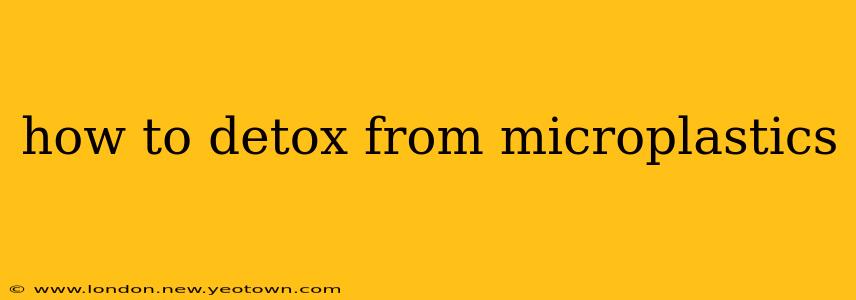The invisible threat of microplastics has become a growing concern worldwide. These tiny particles, less than 5 millimeters in size, are pervasive in our environment, seeping into our food, water, and even the air we breathe. While completely eliminating microplastic exposure is currently impossible, understanding how to minimize intake and support your body's natural detoxification processes is crucial for your health and well-being. This isn't a quick fix; it's a journey toward a healthier lifestyle with a focus on reducing exposure and supporting your body's natural defenses. Let's explore how to navigate this challenge.
What are Microplastics and Why Should I Worry?
Microplastics are essentially tiny pieces of plastic that break down from larger plastic items like bottles, bags, and clothing. They're everywhere – in the ocean, soil, and even the air. The worry stems from their potential impact on human health. Studies are ongoing, but evidence suggests that ingestion of microplastics can potentially lead to inflammation, cellular damage, and hormonal disruption. While the long-term effects are still being researched, minimizing exposure is a proactive step towards protecting your health.
How Can I Reduce My Microplastic Intake?
This is the heart of the matter – actively reducing your exposure. It's a multi-pronged approach that requires mindful choices in your daily life.
1. Choose Wisely: Food and Drink
- Eat less processed food: Many processed foods contain plastic packaging that can leach microplastics into the food itself. Opt for whole, unprocessed foods whenever possible.
- Drink filtered water: Using a good quality water filter can significantly reduce the amount of microplastics you consume through your drinking water.
- Avoid bottled water: Bottled water is a major source of microplastic contamination. Investing in a reusable water bottle and using a filter is a much healthier alternative.
- Be mindful of seafood: Seafood, particularly shellfish, tends to accumulate microplastics. Consider reducing your seafood consumption or choosing sustainably sourced options from reputable fisheries.
2. Clothing and Personal Care
- Wash clothes less frequently: This reduces the shedding of microfibers from synthetic fabrics, which are a significant source of microplastics in our water systems.
- Use a laundry filter: These filters can significantly reduce the release of microfibers into the wastewater during laundry.
- Choose natural fabrics: Opt for natural fibers like cotton, linen, and wool whenever possible.
- Be cautious with exfoliating products: Many exfoliating products contain microplastic beads. Look for natural alternatives that don't contain these particles.
Can I Detox My Body from Existing Microplastics?
Completely eliminating already absorbed microplastics from your body is currently not feasible with readily available methods. However, you can support your body's natural detoxification processes.
1. Support Your Liver and Gut Health
A healthy liver and gut are key to efficient detoxification. Focus on:
- Eating a balanced diet: A diet rich in fruits, vegetables, and whole grains supports overall health and detoxification.
- Hydration: Drinking plenty of water helps flush out toxins from your system.
- Prebiotics and probiotics: These support a healthy gut microbiome, which plays a crucial role in detoxification.
2. Consider Antioxidant-Rich Foods
Antioxidants may help counteract some of the oxidative stress associated with microplastic exposure. Include foods rich in antioxidants in your diet, such as berries, leafy greens, and nuts.
What are the Long-Term Effects of Microplastic Exposure?
The long-term effects of microplastic exposure are still being researched. Studies are ongoing, but potential health risks include inflammation, cellular damage, and hormonal disruption. The focus should be on minimizing exposure as a preventative measure.
Are there specific tests to measure microplastic levels in the body?
Currently, there aren't widely available and standardized tests to accurately measure microplastic levels in the human body. Research is ongoing to develop reliable and accessible testing methods.
Is it possible to completely avoid microplastics?
Completely avoiding microplastics in our modern world is nearly impossible. However, by making informed choices and implementing the strategies discussed above, you can significantly reduce your exposure and support your body’s natural detoxification processes.
This journey towards minimizing microplastic exposure is a continuous process. By embracing mindful consumption, supporting your body's natural defenses, and staying informed about ongoing research, you can take significant steps toward a healthier future. Remember, every small step you take contributes to a healthier you and a healthier planet.

